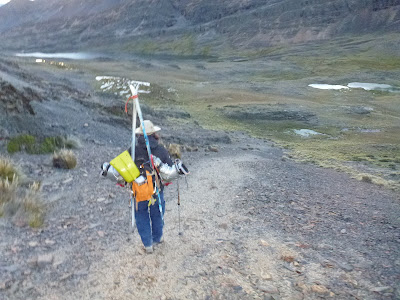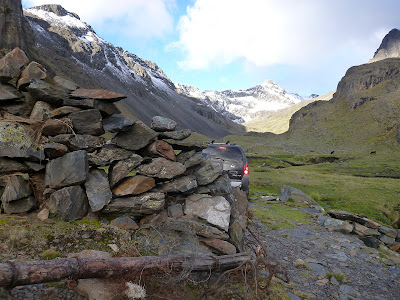The weather forecast once again promised clear skies in the mountains so I planned a trip with Roberto for more skiing. We were ambivalent about where to go and, in the end, decided to head up to Serkhe Khollu in the Hampaturi where we had made a first ascent of an ice climb last October. I had three free days so we thought we'd make an extended trip and ski a few peaks in the area.
Aimee is training for the Lima marathon in May so she wanted to do a 13-mile run in the morning before we left. She asked me to go with her to Lima so I am going to do the half marathon. I am sure I will have more to say about that goat rope later.
Anyway, we had to go to Roberto's house to get his stuff, stop for gas and then at a grocery store for food plus a new chip for Roberto's phone. We managed to roll out of La Paz at noon. Within an hour, we were heading up the valley into the heart of the Hampaturi:
Although it was already two o'clock by the time we reached the end of the road, we decided to see if we could find some snow and make a few turns before dark. Roberto and Serkhe Khollu:
We decide to check out a peak across the valley from Serkhe Khollu and, as we gain height, Lake Titicaca comes into view:
Nice light and clouds on Huyani Potosi:
Roberto with the starts of two of his first ascents on Serkhe Khollu in the background:
We reach the summit of this unnamed peak, which is about 17,700' tall, as the sun abruptly leaves our heretofore pleasantly soft snowfield:
It was cool to reach the summit but it cost us the best conditions for the descent as the surface turned immediately to crust in the shade. Serkhe Khollu has at least one obvious unclimbed line remaining. The ice climb Roberto and I did in October on the left side of the obvious seracs is completely gone but you can see the new route possibility dropping straight down from the right side of the summit:
I ski down in somewhat disappointing conditions considering what they were like as we ascended and watch Roberto:
I get distracted by the scenery:
It seems like I see Tiquimani everywhere I go:
Here comes Roberto:
These slabs probably look better than they are for climbing as most of the rock in this areas seems to be some type of shale:
Huyani Potosi in the twilight:
My style is admittedly somewhat unorthodox:
Roberto slips on some mud and breaks his ski pole which prompts us to give our unnamed peak the unofficial title of Serkhe Fuku. Our line went down the left side from the summit:
Milking the last of the daylight:
We get back to the car at very last light. Those ancient boots Roberto is using are genuine hand me downs from Lowell Skoog:
We decide to go back to La Paz and rest at the oxygen rich 11,000' level and then leave for another destination after a good night sleep. For a minute, we thought the locals, who are developing two mines in the area and who take an intense, but friendly, interest in visitors, had locked us in because we had told them we were staying overnight but it turned out that the gate wasn't really locked:
Or we could have wound up like this fellow:
We set the controls for La Paz and slowly made our way down the braided tracks out of the Hampaturi:
Not bad for a half day's work.





















































